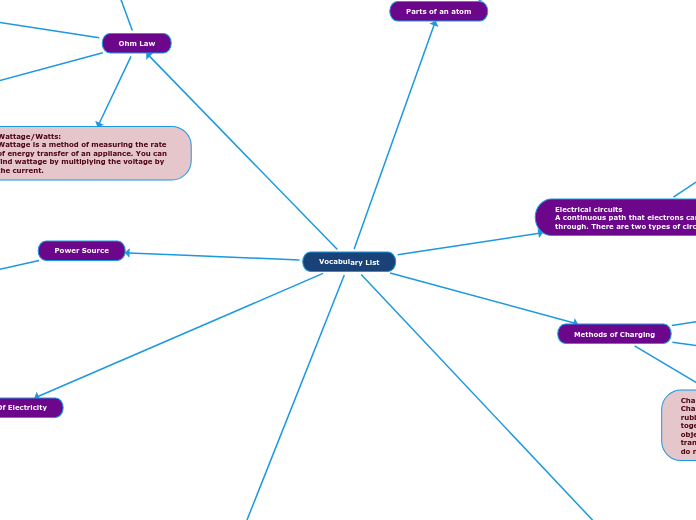Vocabulary List
Ohm Law
Current: (I)
Current is the movement/flow of electrical charge/ electricity. Current is the measurement of how much charge passes through a point in one second. Current is represented using the symbol (/)
Amperes/Amperage:
Current is measured in units known as amperes/amps. Amperes is the SI base unit of electrical current.
Ammeter:
Current is measured using a device called an ammeter.
Voltage: (V)
Voltage is a measure oft the amount of energy per coulomb.
Potential difference:
Potential difference is the difference in voltage between two points.
Voltmeter:
Voltage is measured using a device called a voltmeter. The voltmeter measures the electric potential in volts.
Resistance: (R)
Resistance is a physical property that describes how a material impeded the flow of electrons.
Wattage/Watts:
Wattage is a method of measuring the rate of energy transfer of an appliance. You can find wattage by multiplying the voltage by the current.
Power Source
A power source is a source of power.
Example:
A power source is often a battery or a generator.
Electrical circuits
A continuous path that electrons can flow through. There are two types of circuits.
Parallel Circuit:
Parallel circuits have more than 1 pathways that current/electrons flow through. Parallel circuits have branching points where the current can flow along different paths.
Series circuit:
A series circuit only has 1 path that current/electrons flow through and the electrons push each other ahead.
Methods of Charging
Charging By Friction:
Charging be friction happens when 2 rubbing two different typed of ebjects together will transfer electrons from one object to the other. when charging is the transfer of electrons, protons and neutrons do not move/transfer.
Charging By Contact:
Charging by contact can only occur by contact through the transfer of electrons. When charging by contact there must be a difference in the amount of charge between the two objects.
Charging By Induction:
Charging by induction is when an object is charged without direct contact. Bringing a charged object close to a neutral object will induce the same charge in the neutral abject.
Parts of an atom
Proton:
A proton is a subatomic particle found in the nucleus. Protons are positive and they have a charge of (+1)
Neutron:
A neutron is a subatomic particle found inside of the nucleus. Neutrons are neutral and have a charge of Zero.
Electron:
Electrons are found in orbit around the nucleus. Electrons are negative and they have a charge of (-1)
Flow Of Electricity
insulators:
Insulators are materials that impede the flow of electrons from atom to atom.
Examples:
yarn, plastic, cloth, rubber, and wood.
Conductors:
Conductors are materials that allow electrons to flow freely from particle to particle.
Examples:
Good conductors are metals that are ductile/can be pulled into wires. Some metals that are often used are copper, steel, gold aluminum, iron etc.
Static Electricity
Laws of Electro-Static
Attraction:
Opposite charges attract each other
(-)-><- (+)
Charged and neutral objects attract each other.
(n) -><- (+)
Repulsion:
Like Charges Repel
<- (+) (+)->
Electricity Generation
Renewable resources:
A renewable resource is a natural resource that can be re made by the earth often.
Examples:
Lightning, solar energy, hydro energy, wind energy, biomass energy, trees and lumber
Non-Renewable:
A nonrenewable resource is a natural resource that can not be rapidly replaced naturally.
Examples:
Coal, gas, oil, nuclear energy, natural gasses.
